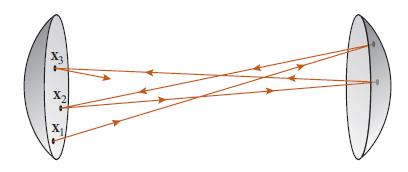Consider two spherical mirrors, each with radius of curvature R, separated by distance d so as to
Question:
Consider two spherical mirrors, each with radius of curvature R, separated by distance d so as to form an optical cavity (Fig. 7.9). A laser beam bounces back and forth between the two mirrors. The center of the beam travels along a geometric-optics ray.
(a) Show, using matrix methods, that the central ray hits one of the mirrors (either one) at successive locations x1, x2, x3, . . . (where x ≡ (x, y) is a 2-dimensional vector in the plane perpendicular to the optic axis), which satisfy the difference equation
![]()
where

Explain why this is a difference-equation analog of the simple-harmonic-oscillator equation.
(b) Show that this difference equation has the general solution
![]()
Obviously, A is the transverse position x0 of the ray at its 0th bounce. The ray’s 0th position x0 and its 0th direction of motion ẋ0 together determine B.
(c) Show that if 0 ≤ d ≤ 2R, the mirror system is stable. In other words, all rays oscillate about the optic axis. Similarly, show that if d > 2R, the mirror system is unstable and the rays diverge from the optic axis.
(d) For an appropriate choice of initial conditions x0 and ẋ0, the laser beam’s successive spots on the mirror lie on a circle centered on the optic axis. When operated in this manner, the cavity is called a Harriet delay line. How must d/R be chosen so that the spots have an angular step size θ?
Fig 7.9.

Step by Step Answer:

Modern Classical Physics Optics Fluids Plasmas Elasticity Relativity And Statistical Physics
ISBN: 9780691159027
1st Edition
Authors: Kip S. Thorne, Roger D. Blandford





